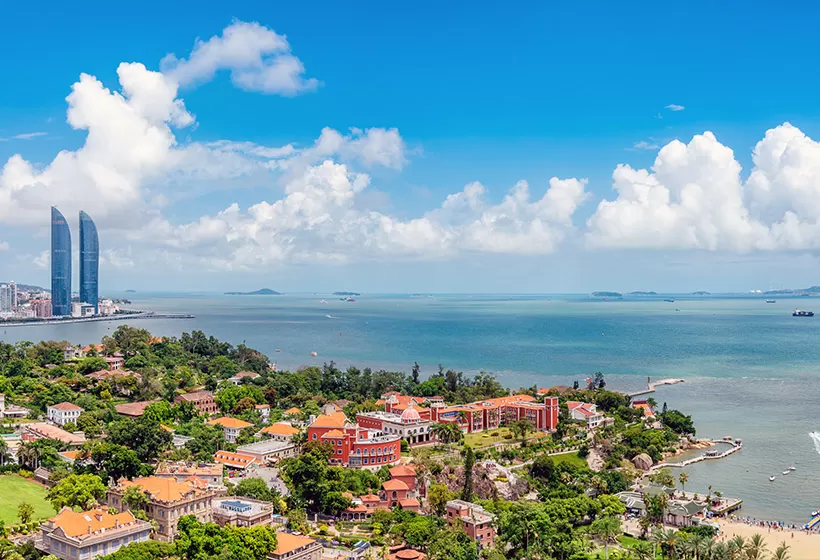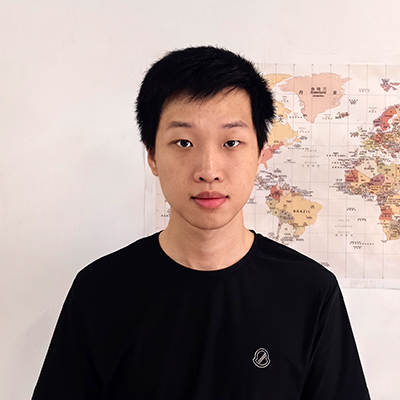Short Introduction to Xiamen Local Culture: History, Religion, etc.
Xiamen, abbreviated as "Xia", also known as "Egret Island", is located on the southeastern coast of Fujian Province. It borders Zhangzhou to the west, Quanzhou to the north, and faces Greater and Lesser Kinmen as well as Dadan Island across the sea to the southeast. The total area of Xiamen is 1,700.61 square kilometers.
The city's territory includes the mainland area along Xiamen Bay in southeastern Fujian, as well as several islands such as Xiamen Island and Gulangyu. Xiamen Bay itself is also part of the city's domain. Together with Zhangzhou and Quanzhou, Xiamen forms the Hokkien Golden Triangle Economic Zone. Renowned for its beautiful environment, Xiamen is a city where the sea and the urban landscape intertwine, and it is often praised as a "Garden on the Sea" and a "City of Warmth".
Brief History
In ancient times, Xiamen Island was a habitat for egrets, hence its nickname "Egret Island". During the pre-Qin period, it belonged to the land of the Baiyue people. Under the Western Jin dynasty, a short-lived Tong'an County was established, but it wasn't until more than 600 years later that the area truly began to develop.
During the Sui and Tang dynasties, Xiamen was part of Nan'an County. In the mid-Tang period, the administrative division of Jiahe Li (a lower-level division of township) was set up on Xiamen Island. Thus, Xiamen also came to be known as "Jiahe Island".
Before the Ming dynasty, Jiahe Island was just one of many coastal islands in Fujian, with no particular prominence. In 1394, the Ming government built Xiamen City here as a key point for coastal defense, marking the first appearance of the name "Xiamen".
During the Qing dynasty, the Admiral of the Fujian navy moved to Xiamen, followed by the Deputy Commissioner of Maritime Defense for Quanzhou Prefecture. This made Xiamen a growing military, political, and economic center along Fujian's southeastern coast.
After the Opium War, Xiamen Island became a treaty port, opening up as an international harbor. In 1902, Gulangyu became a "foreign settlement" administered by multiple countries. Following the Xinhai Revolution, Xiamen was liberated, ending Qing rule on the island.
During the Republican period, Xiamen developed rapidly, though it still administratively belonged to Jiahe Li of Tong'an County. Over time, it was gradually elevated in status and officially became Xiamen City in 1935.
After the founding of the PRC, Xiamen's jurisdiction expanded beyond the island. In 1980, Xiamen Special Economic Zone was established, which spurred rapid regional development. Today, Xiamen is not only a key city in Fujian Province but also a nationally renowned tourism and economic hub.
City Icon
In October 1986, based on a public vote, the 23rd meeting of the Standing Committee of the 8th Xiamen Municipal People's Congress officially designated bougainvillea as the city flower, the royal poinciana as the city tree, and the egret as the city bird of Xiamen.
City Flower
As the city flower of Xiamen, the bougainvillea, renowned for its vibrant blossoms and tenacious vitality, has become a unique ecological and cultural emblem of the city. Originally native to Brazil in South America, the bougainvillea was introduced to China long ago. Today, its brilliant blooms can be seen throughout the streets, alleys, parks, and squares of Xiamen, sometimes blazing like fire, other times soft and elegant, adding endless charm to the city.
City Tree
The royal poinciana, or flamboyant tree, serves as the city tree of Xiamen and symbolizes passion and inclusiveness. Also known as "fire tree" it originates from Africa and is widely cultivated in southern China. Xiamen's mild, rainy climate and abundant sunlight provide ideal conditions for its growth. During peak blooming season, the flamboyant trees create a spectacular sight of a road lined with red blossoms like silk ribbons, painting the city in vivid hues.
City Bird
Xiamen is also known as "Egret Island", as flocks of egrets have long called this place home, therefore they are the city bird of Xiamen. The city's numerous wetlands provide a natural haven for their survival. Egrets are naturally graceful, with slender bodies and snow-white plumage, resembling a noble Snow White. During the breeding season, two strands of elegant aigrettes grow on their heads, floating like the ribbons of celestial beings.
Religious Belief
In Xiamen, while the major religions include Taoism, Buddhism, and Islam, alongside Hinduism, Christianity, and Manichaeism, the most distinctive feature lies in the local folk beliefs. In addition to worshipping deities traditionally revered across China, such as the Tudigong, locals also venerate historical figures who have been deified, including Poh Seng Tai Tay, Mazu, Kong Tek Chun Ong, and Patriarch Ching Chwee.
Buddhism remains the dominant religion, with tens of thousands of followers. The ancient South Putuo Temple and Minnan Buddhist College enjoy great renown both in China and abroad. The Christian New Street Church is hailed as "China's First Holy Church", while the Catholic Diocese of Xiamen is based on Gulangyu Island and serves as a hub for Catholic international exchange in southern Fujian. Notable temple fairs include the Cross-Strait Temple Fair and the Brahma Temple Fair, reflecting the region's rich and diverse religious traditions.
Qilou Culture
The Qilou originated from Western-style colonnaded architecture and was first seen in Singapore. Over a hundred years ago, a large number of Minnan people migrated from Xiamen to Southeast Asia. After generations of hard work and accumulation, many eventually returned home and brought back foreign architectural styles, incorporating them into local buildings, thus introducing the Qilou back to their homeland.
Kaiyuan Road, the first modern road in Xiamen, became the birthplace of this style. On its roughly 10-meter-wide street, all kinds of businesses flourished, grain shops, dried goods vendors, inns, and more. The area was convenient for commerce and shopping, and it was here that the Qilou style imported from Southeast Asia first appeared in Xiamen.
From there, the architectural trend spread to places like Zhongshan Road and Dasheng Li. Within just over a decade, Xiamen had transformed into a "city of Qilou". These buildings typically featured an arcade at ground level facing the street for pedestrian use, with the second floor extending over the walkway, as if the appearance of it "riding" on top of the ground level, therefore this kind of building names "Qilou (Riding House)" in Chinese.
Qilou buildings served both residential and commercial purposes: the ground floor was used as a shopfront and walkway, while the upper floors served as living quarters. During the Qing Dynasty, Xiamen was one of five Chinese treaty ports opened to foreign trade. Many Minnan people returning from Singapore began building Qilou to open shops, and the dual-function design of commerce below and residence above was a perfect match for the demands of that time.
Diet Style
Xiamen cuisine, an important branch of Fujian cuisine, one of China's eight major culinary traditions, retains strong Fujian characteristics. Since the Tang and Song dynasties, as cities like Quanzhou and Xiamen opened to foreign trade, culinary techniques across the world made their way into the region. Xiamen cuisine absorbed the essence of various regional styles, gradually forming a distinctive identity centered on Minnan flavors while incorporating elements of Taiwanese and foreign cuisine, renowned for its diverse ingredients, meticulous selection, refined preparation, sophisticated cooking methods, and unique flavors.
Xiamen cuisine excels particularly in seafood dishes, also known for its traditional snacks, vegetarian dishes, and medicinal cuisine, earning it acclaim both domestically and abroad. With its proximity to both mountains and sea, Xiamen boasts a wide variety of ingredients, especially seafood, and seafood Dapaidang (open-air eateries) are popular among tourists. The city's snacks are famously versatile, serving as both light bites and full meals, with century-old offerings like sipunculid worm jelly and shacha noodles. Xiamen also had many temples and nunneries where monks and nuns mastered the vegetarian cooking, and many believers observe meatless diets during religious periods. Moreover, the Minnan people place special emphasis on medicinal cuisine. Due to the region's humid climate, locals often use herbs in their cooking for nourishment, so it's common to find medicinal ingredients woven into many dishes.
Cultural Heritage
As a UNESCO World Cultural Heritage site, Gulangyu Island is renowned as a "Museum of International Architecture". It showcases a rich blend of Eastern and Western styles from the mid-19th to early 20th centuries, featuring everything from the spires of Gothic churches to the charm of red-brick houses. The Piano Museum in Shuzhuang Garden displays century-old instruments, while the statue of national hero Zheng Chenggong stands tall on Fuding Rock in Haoyue Park, telling the lofty aspirations of national heroes. The Hulishan Fortress bears witness to a century of war and smoke, echoing with the sounds of past battles. In Jimei School Village, the fusion of Minnan red-brick architecture and Southeast Asian-style glazed tile roofs reflects the deep love of overseas Chinese for their homeland.
As you stroll through the streets of Xiamen, you'll often encounter intangible cultural heritage alive in every corner of the city. Lacquer thread sculpture, a treasure of Chinese lacquer art, is known for its delicate and elegant workmanship, lifelike details, and solemn, antique style. Xiamen pearl embroidery, originating from the Tang Dynasty, is famed for its exquisite design and bold color contrasts, shimmering like a relief under the light. Xiamen glove puppetry, praised as "art at the fingertips", brings characters' joys, sorrows, and passions to life through the dexterous manipulation of puppets with the fingers.
Customize Your Egret Island Xiamen Tour

If you are interested in the Xiamen itineraries mentioned above, please contact us, and we will be happy to customize it and provide a quote tailored to your preferences.
Alternatively, if you would like to customize your Xiamen Tour, please visit our Xiamen Tour Customized Center. We assure you that you will receive a reply within 24 working hours.
Informative Articles for Your Xiamen Trip
 Meat Zongzi
Meat Zongzi- Travel Guide: attractions, weather, culture, etc.
- Weather: best time and seasons to visit Xiamen
- Top attractions: sightseeings to watch in Xiamen
- Local culture: brief history, folk culture, food, etc.
- Top destinations: best places to visit in Xiamen
- Travel itineraries: itineraries for your reference
- Unique perspective: top interesting things to do
- Local food: what to eat while traveling in Xiamen
- Luxury hotels: accommodation to stay in Xiamen
- Xiamen Tours: customized tours for your reference
GREAT FAMILY CHINA TOUR
JULY 2024 We wanted to thank Grace at China Culture tour for organizing a great tour of China. We enjoyed our Beijing - Xian-Chengdu -Guilin -Yangshuo - Shanghai trip. Our local guides Bruce in Beijing, Susan in Xian, Jane in Chengdu, Mike in Guilin and Mary in Shanghai took care of us…read more details »
Teng Han L from SINGAPORE
Ready to Create a Unique Dream Travel?


